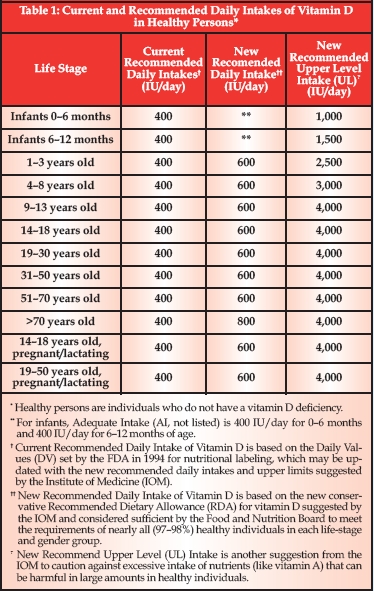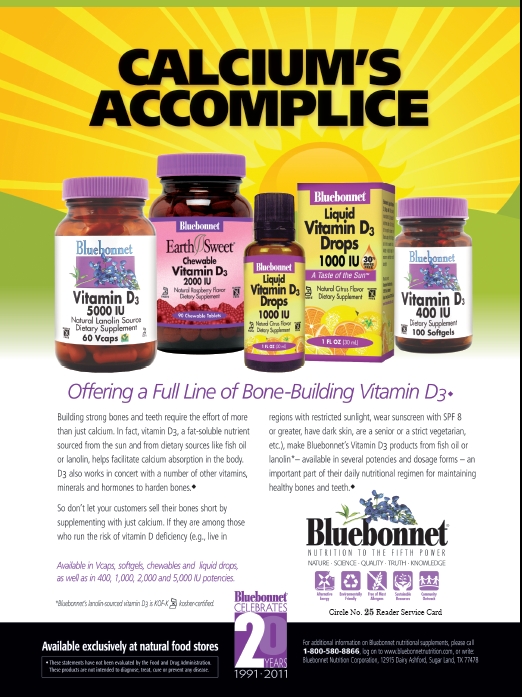1. What is the importance of vitamin D in the body?
Vitamin D is a fat-soluble nutrient that requires conversion in the liver and kidneys to form the physiologically active form of vitamin D known as calcitriol. Active vitamin D functions as a steroid hormone in the body, augmenting calcium and phosphorus absorption in the kidneys, which helps to form and maintain healthy bones and teeth. The principal physiological function of vitamin D is to maintain normal blood levels of both calcium and phosphorus, as well as to promote bone mineralization.

2. What happens if you don’t get enough vitamin D?
If insufficient amounts of vitamin D are consumed or synthesized, a vitamin D deficiency may ensue and cause abnormal bone formation. Osteopenia is low bone mass, which is a risk factor for osteoporosis—the most severe form of bone loss. In children, this is known as rickets, and in adults, it is known as osteomalacia. Rickets/osteomalacia result in soft bones and skeletal deformities due to a lack of calcium and/or phosphate in the protein bone matrix, which may be caused by poor diet, lack of vitamin D and/or inadequate sunlight exposure. However, it should also be noted that vitamin D is not just for skeletal/bone health. It has also been reported in scientific literature that vitamin D levels are crucial for immune and cellular health, as well as for controlling various hormone systems.
3. What is the difference between vitamin D2 (ergocalciferol) and D3 (cholecalciferol)?
There are two forms of vitamin D: D2 and D3. Vitamin D2 (ergocalciferol) is found in mushrooms, yeast and other plants that have been exposed to ultraviolet light, while vitamin D3 (cholecalciferol) is a fat-soluble vitamin found in food or sheep’s wool (lanolin) and is also made by the body from cholesterol in a multi-step process that is activated by sunlight. Vitamin D3 in particular has actually been reported to be more bioavailable than vitamin D2. In fact, in a recent study, vitamin D3 was three times more potent in increasing stored vitamin D content in the body than D2, as well as being more potent than D2 in raising circulating vitamin D levels in the blood by 87% after supplementation. Although vitamin D3 is the superior form of vitamin D in the body, for a true vegan/vegetarian formula, vitamin D2 must be utilized.
 4. Who would most benefit from vitamin D supplementation?
4. Who would most benefit from vitamin D supplementation?
Vitamin D deficiency is more common in individuals who live in regions where there is restricted sunlight exposure (north of 42 degrees latitude) or a high level of atmospheric pollution, strict vegetarians, dark-skinned people, individuals who constantly wear sunscreen and seniors who primarily stay indoors or are immobile.
5. Which dosage form (e.g., softgels, liquids, chewables, etc.) is best suited for consumers?
Supplements today come in a variety of dosage forms, including vitamin D3 Since vitamin D3 from fish oil is fat-soluble, it is typically best to consume this source of vitamin D3 in a softgel whereby the nutrient is surrounded by a lipid (fat) matrix allowing for more efficient delivery into the small intestine and subsequent absorption into the body. However, fish is one of the top eight food allergens in the world; therefore, lanolin-based vitamin D3 would be preferable if your customer is allergic to fish, suffers from GI upset when taking fish oil, or has fat malabsorption issues. Lanolin-based vitamin D3 is the only source of vitamin D3 that can be kosher-certified and is often found in vegetarian capsules, chewables and liquids.
Liquid and chewable vitamin D formulas offer flavor, ease of administration, increased compliance and, most importantly, digestibility. With liquid and chewable formulas, the amount of time it takes for this nutrient to go from the stomach to the small intestine for absorption is miniscule. Capsules and tablets can take up to 30 to 45 minutes to break down, which is the disintegration/dissolution time limits set by the U.S. Pharmacopeia.
6. There has been a push recently for an increase in the Dietary Reference Intake (DRI) of vitamin D. What are the new levels that are being discussed and how will this information affect my customers?
The Institute of Medicine (IOM) recently reported its new recommendations for vitamin D intake in healthy individuals at certain life stages, which is detailed in Table 1.
The most important take-away message from these conservative IOM recommendations is that they are geared toward “healthy individuals” not those who are susceptible to vitamin D deficiency as discussed in Question 4. If your customer has healthy blood levels of vitamin D, then supplementation should hit the ceiling at 4,000 IU/daily to fill dietary gaps. However, if a deficiency (i.e., < 30 ng/mL) is present, then a healthcare practitioner may suggest higher potencies ranging from 5,000 to 10,000 IU/daily or even higher. Bluebonnet has a variety of vitamin D3 products from lanolin and fish oils in multiple delivery systems [e.g., liquid drops, chewables, softgels, and vegetarian capsules (Vcaps)] and in several potencies (400, 1,000, 2,000 and 5,000 IU) to help meet your consumers’ varying nutritional needs.
References
Bikle, D.D. (2010). Vitamin D: Newly Discovered Actions Require Reconsideration of
Physiologic Requirements. Trends in Endocrinology and Metabolism, 21, 375–384.
Dietary Reference Intakes for Calcium and Vitamin D. Institute of Medicine of the
National Academies. Washington, DC: National Academies Press; 2010.
Heaney, R.P., Recker, R.R., Grote, J., Horst, R.L.., & Armas, L.A. (2010). Vitamin D3 Is
More Potent Than Vitamin D2 in Humans. The Journal of Clinical Endocrinology &
Metabolism, doi:10.1210/jc.2010-2230.
Valdivielso, J.M., & Fernandez, E. (2006). Vitamin D Receptor Polymorphisms and
Diseases. Clinica Chimica Acta, 371, 1–12.
Trisha Sugarek holds a Master’s in Nutrition from Texas Woman’s University and also a Bachelor’s of Science Degree in Nutrition and Food Sciences from Texas State University. Ms. Sugarek is currently the national educator as well as a research and development specialist at Bluebonnet Nutrition where she investigates new ingredients, assists in the launch of new products, and provides industry training on numerous subjects as it relates to the connection between nutrition and health. She is a frequent editorial contributor and lecturer on the benefits surrounding the responsible use of supplements.
Published in WholeFoods Magazine, February 2011










